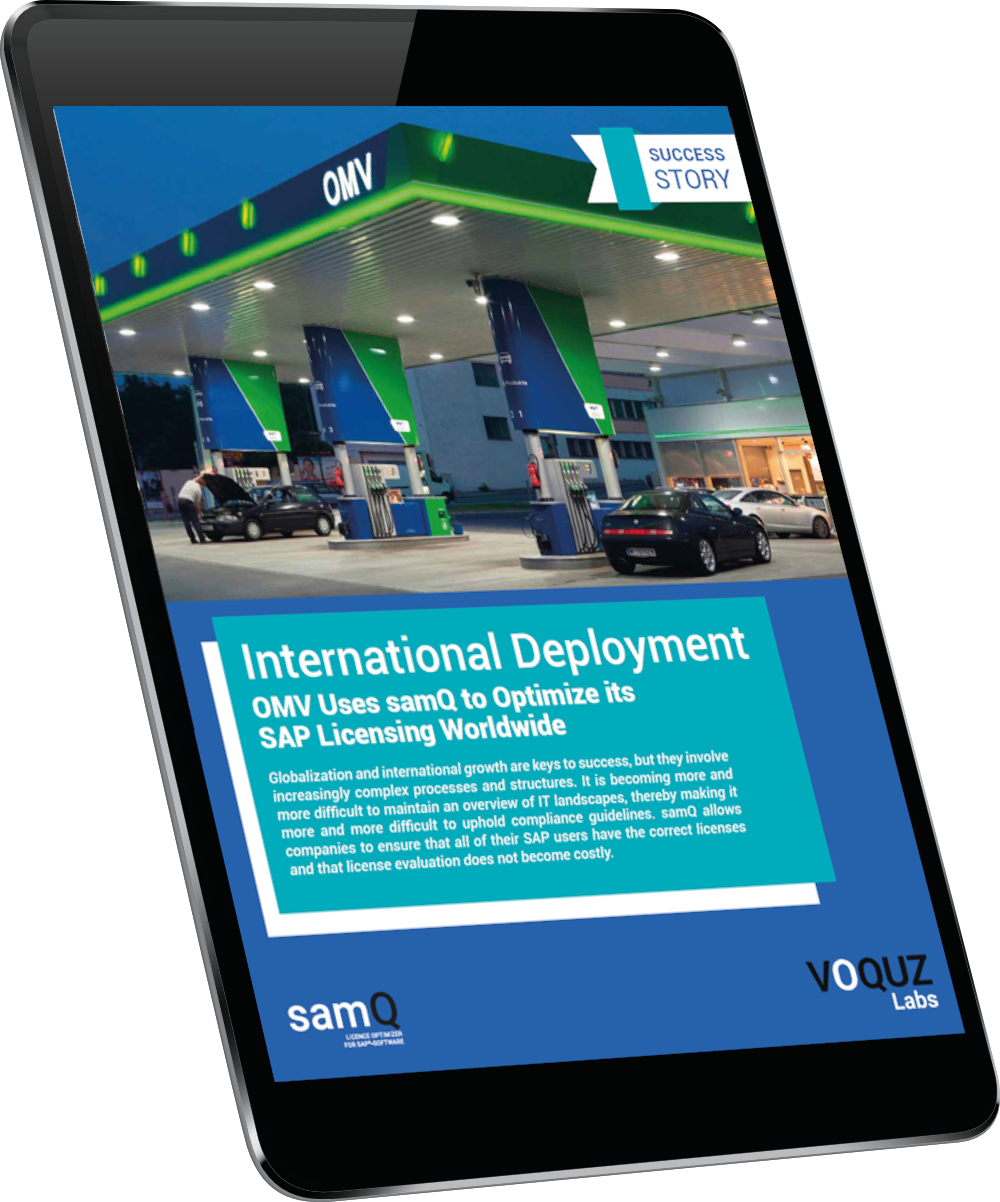REFERENCES
OMV uses samQ to optimize its SAP Licensing worldwide
OMV is an international oil and gas company based in Vienna, Austria, that works in both the upstream and downstream fields. It was founded in 1956, and last year the Group generated sales of around €23 billion. With approximately 24,100 employees and a market capitalization of €9 billion (as of the end of 2015), OMV is one of Austria’s largest listed industrial companies.
VOQUZ spoke with Michael Keck and Peter Stroi, mem-bers of the OMV IT team at the OMV Global Solutions SAP Competence Center.
VOQUZ: What was the main reason that you researched SAP license management tools?
Michael Keck: We had very clear and simple motivations for doing so. Up until now, we always carried out system evaluations and system and user classifications manually, in direct response to events. Although this only ever entailed intermittent bursts of effort, these always took up a great deal of time and personnel resources. Because of that, we sought out an option that would automate these processes and make them transparent and repeatable on short notice.
VOQUZ: How did you handle license management in the past? How did you manage SAP licenses?
Michael Keck: Manually managing the licenses was a challenge, given the complexity of our SAP system landscape. We prioritized certain processes and heavily focused on users with expensive license types, such as the SAP Business Suite Professional users. We thoroughly analyzed them with regard to their usage behavior so that only users who really required these types of licenses would receive them.
Peter Stroi: However, we were not able to put in the same amount of effort for all of our SAP users. This is because we operate a wide range of productive ERP systems that are used by several thousand users, and they also work in several systems. Managing all of these manually entails an enormous amount of effort.
VOQUZ: How did you assign licenses to the other SAP users?
Michael Keck: We categorized users by their authorizations. These served as a basis for determining and assigning the named user license.
Unfortunately, this assignment method does not take into account the fact that authorizations don’t always correspond to actual usage behavior. Because of that, uncertain-ties arose in our old licensing strategy, which were unavoidable despite our greatest efforts.
Peter Stroi: That was why we were looking for a way to optimize licensing. We wanted to successfully carry over the proven method that we used for issuing more expensive types of licenses to all of our other SAP users. After all, that is the only real way to issue licenses in a fully compliant and audit-secure way. However, it is only possible to do so with a professional software tool.
VOQUZ. How did you go about selecting the tool?
Peter Stroi: The usual way. First, we took a look at the market to see what kinds of tools and aids were out there for license management. Of course, there are very complex SAM tools available that we could use to evaluate all kinds of software in the company. However, we consciously chose to only focus on SAP. This was because we needed a tool that would fulfill our requirements in that particular area to the greatest possible extent.
Michael Keck: Naturally, the cost-benefit ratio was an important factor, and it was one of the main reasons we chose samQ. Based on that, we decided to go for a proof of concept and set up a test installation together with VOQUZ. That went incredibly quickly; within a few hours, samQ had been installed on our SAP Netweaver system. We only needed to make a few settings before receiving our initial results. That was really impressive, and it won us over.
VOQUZ: What did you do next?
Michael Keck: Based on the findings of the test installation, we quickly decided to put samQ into productive use. We installed and set up samQ in May 2015, and it went very smoothly. We made a few changes and expansions
VOQUZ: Were there special requirements or considerations that you had to take into account when implementing samQ?
Peter Stroi: Yes, there was something that we have subsequently implemented. For internal billing purposes, we needed a grouping by e-mail domain. Because of that, we set up samQ so that we could set different licenses depending on the e-mail domain. Even though this functionality was not available as a standard, we were able to easily implement it together with VOQUZ.
VOQUZ: Now that the optimization is complete, what does your license inventory look like? Has it changed a great deal?
Michael Keck: It is not possible to make retroactive changes to SAP agreements, but we will be able to manage our future licensing costs more efficiently. We know the exact level of usage for our license types, on practically a day-to-day basis, thanks to samQ. That means we will save a lot of money on our future additional purchase and maintenance costs, all the while ensuring that we are 100 percent compliant with our agreement.
VOQUZ: What do you think is the greatest added value for the OMV Group in using samQ?
Michael Keck: Thanks to samQ, we now have the opportunity to transparently document and evaluate the licensing situation in our company on a daily basis. We can start evaluating our systems at any time and no longer need multi-week lead times to do so.
VOQUZ: And has the first SAP license evaluation already taken place since samQ was rolled out?
Michael Keck: Yes, it has. At the end of last year, SAP came to carry out an on-site audit at our company for the first time. The audit results confirmed that the OMV Group is using SAP licenses in compliance with the agreement.
VOQUZ: We are happy to hear that. Thank you very much for speaking with us!




